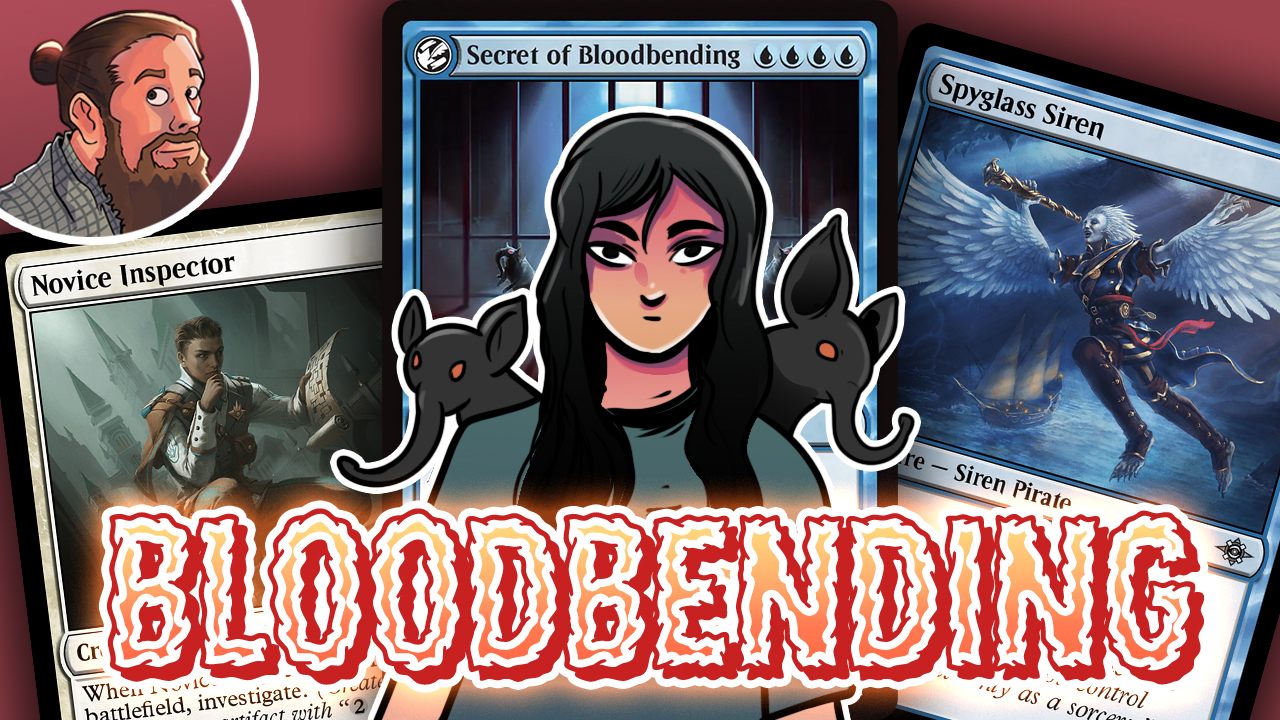Budget Magic: $94 Witherbloom Plumb Aristocrats (Modern)
Selamat siang, Budget Magic lovers, it's that time once again! This week, we're exploring the power of Strixhaven in Modern! Plumb the Forbidden might be one of the most powerful cards from the entire set and one of the best uncommons printed in a long time, but it is good enough to power a Golgari aristocrats budget brew in Modern? Let's get to the video and find out; then, we'll talk more about the deck!
Another quick reminder: if you enjoy Budget Magic and the other content on MTGGoldfish, make sure to subscribe to the MTGGoldfish YouTube channel to keep up on all the latest and greatest.
Budget Magic: Witherbloom Plumb Aristocrats

The Deck
Witherbloom Plumb Aristocrats is a sacrifice deck. Our main goal is to stack up a couple of payoffs like Blood Artist, Zulaport Cutthroat, and Dina, Soul Steeper; sacrifice a bunch of random dorks to things like Plumb the Forbidden and Carrion Feeder; and hopefully drain our opponent out of the game with death triggers. The deck basically comes in three parts: sacrifice payoffs, sacrifice fodder, and sacrifice outlets. Let's start with the cards that can actually win us the game: our sacrifice payoffs.
The Payoffs



When it comes to killing our opponent, our main play is to sacrifice our board with Blood Artist, Zulaport Cutthroat, and / or Dina, Soul Steeper on the battlefield. Blood Artist and Zulaport Cutthroat are basically the same card: when one of our creatures dies, we get to drain our opponent for one. This allows us to chip in for damage throughout the game while also keeping our life total high, before eventually getting to a position where we have enough creatures on the battlefield (and enough payoffs) to sacrifice everything and win the game on the spot. Dina, Soul Steeper is a bit strange. It doesn't do much of anything without a Blood Artist or Zulaport Cutthroat, but if we have one of our other payoffs on the battlefield, it essentially functions like another Blood Artist / Zulaport Cutthroat because when we drain with Blood Artist / Zulaport Cutthroat, we'll trigger Dina, Soul Steeper to drain again, essentially doubling all of our death triggers. Dina, Soul Steeper also works as a backup sacrifice outlet. While it is the weakest sacrifice outlet in our deck because it costs a mana to activate and doesn't really do anything special (it's unlikely we'll actually win by pumping Dina), it is a nice backup plan if we happen to not find our other, better sacrifice outlets. In general, we'd like to get at least two of these cards on the battlefield to be able to combo off and win the game, and in general, we're happy to draw as many of these cards as possible since their abilities stack.
Sac Fodder



While we'll sacrifice any of our creatures if it will help us win the game, we do have three creatures specifically in the deck to be sacrificed: Blisterpod, Tukatongue Thallid, and Young Wolf. The power of these three one-drops is that they each leave behind a body when they die, with Blisterpod and Tukatongue Thallid making tokens and Young Wolf returning to the battlefield as a 2/2 thanks to undying. This does two things for our deck. First, in the early game, we can sacrifice these cards more or less for free to draw cards with Village Rites or Plumb the Forbidden. Second, later in the game, once we have a couple of our Blood Artist–style payoffs on the battlefield, each of these cards represents two "dies" triggers for just a single mana, which helps give us enough bodies to sacrifice to drain our opponent out of the game.
Sacrifice Outlets


After playing the deck a bunch, I'm convinced that Plumb the Forbidden and Village Rites are—by far—our two most important cards. If you look at our deck, we have 28 creatures, all of which have zero or one power. The way we win the game is by generating a critical mass of small bodies, and for this plan to work, we need to keep drawing through our deck to find more random 1/1s to play. Village Rites offers a one-mana Divination with upside since, in our deck, sacrificing a creature is usually a benefit rather than a drawback. Meanwhile, Plumb the Forbidden is an absurd finisher, offering us an uncounterable way to sacrifice any number of creatures at instant speed for just two mana. While we do use it for value to draw through our deck, one of the most common ways for Witherbloom Plumb Aristocrats to win the game is to build a big board of dorks, play a couple of payoffs, and sacrifice our entire board to Plumb the Forbidden to drain our opponent for 10 or 20 damage to win the game.


While Plumb the Forbidden and Village Rites are all-star sacrifice outlets, we also have a couple of creatures that can get the job done as well. Both Carrion Feeder and Viscera Seer can sacrifice our entire board for free, while Carrion Feeder can also grow into a massive threat if we can sacrifice enough bodies. Another sneaky aspect of both cards (and, really, all of our sacrifice outlets) is that they allow us to fizzle exile-based removal like Path to Exile and Skyclave Apparition. Our deck has a couple of ways to recur threats from our graveyard, which means we'd much rather have our creatures end up in the graveyard than in the exile zone. Having a Carrion Feeder or Viscera Seer sitting on the battlefield, in a weird way, offers some protection for our other, more important creatures.
Other Stuff



Rounding our our main deck are Fatal Push for removal (which is better in our deck than in most non-fetch-land budget decks since we can easily sacrifice creatures to trigger revolt and kill bigger threats), along with Unearth and Lurrus of the Dream-Den as our companion to replay creatures that we sacrifice. Unearth is pretty great in our deck, either offering us a way to reanimate a payoff that dies before we combo or supporting our combo by reanimating something like Blisterpod that offers two more bodies to sacrifice (and a bunch more death triggers from our Blood Artists). Meanwhile, Lurrus of the Dream-Den is a free-roll since all of the permanents we want to play cost two or less mana anyway. But we're not playing the Nightmare Cat just because we can—it's actually great in our deck since our whole gimmick is sacrificing small creatures, which means Lurrus of the Dream-Den usually has plenty of good options to cast from our graveyard by the time it hits the battlefield.
Mana



Our mana is pretty typical for a budget deck, with three of the cheapest Golgari duals that have some chance of coming into play untapped. While Blooming Marsh and Llanowar Wastes are solid, Necroblossom Snarl can be pretty infuriating in a deck with only six Swamps / Forests. Unfortunately, there just aren't a lot of options for dual lands that might come into play untapped on occasion in the $2 price range, so it might be a necessary evil, although I'm not 100% sure that playing Necroblossom Snarl is better than just playing a few more basic lands.
Playing the Deck
The most important thing to realize about Plumb Aristocrats is that it's a combo deck. Even though we have a lot of cheap creatures, which might make it look like an aggro build, our creatures simply don't have enough power to win by attacking. As such, rather than beating down, we're often staying back on defense, chump blocking (especially if we have some drain payoffs like Blood Artist on the battlefield), and trying to manipulate the game to a position where we can win with by sacrificing our board.
Focus on keeping up sacrifice effects like Village Rites and Plumb the Forbidden. Getting creatures exiled is brutal for our deck since we'll lose the creature forever and can't replay or reanimate it. It's often better to leave up mana to cast a sacrifice card-draw spell than to deploy another threat.
Speaking of Plumb the Forbidden, while the games where it sacrifices our entire board for lethal are great, it's perfectly fine to cast it early to sacrifice two or three creatures and refill our hand. We have a lot of ways to sacrifice our creatures, so don't worry too much about spending a Plumb the Forbidden early, especially if we can get some extra value, like fizzling one of our opponent's removal spells or getting a free-ish block in on a big creature.
You probably noticed that our deck doesn't really have that much removal. That's because our deck is really, really good at blocking. Cards like Blisterpod, Tukatongue Thallid, and Young Wolf can all block twice, and then, we eventually can recast / reanimate them to block two more times. This is a really good way to shut down decks with a few big threats; plus, we don't really mind our creatures dying since we're likely getting some triggers from Blood Artist and friends.
By far the cards our deck is most scared of are things like Leyline of the Void and Rest in Peace. While graveyard hate in general is annoying, these enchantments also stop Blood Artist and Zulaport Cutthroat by creating a replacement effect that makes it so that creatures go to exile rather than dying. We have Caustic Caterpillar and Maelstrom Pulse in our sideboard specifically to answer these cards. If you think there's a chance the opponent will be bringing them in, make sure to sideboard in the answer because it's almost impossible for our deck to win if a Rest in Peace or Leyline of the Void sticks on the battlefield.
Wrap-Up
All in all, we went 4-1 with Witherbloom Plumb Aristocrats, and the deck felt solid in general. We did get crushed by Heliod Combo, which does exemplify one of the deck's weaknesses: we're not great against fast combo. Our deck can grind all day against control, gains life against aggro, stonewalls midrange with chump blockers, and is mostly impervious to removal, but if our opponent is comboing off on Turn 3 or 4, we're not usually fast enough to win. Duress in the sideboard can help, although it's not usually enough.
As far as changes to make to the budget build of the deck, the only card I really dislike is Necroblossom Snarl. But as I mentioned before, it might just be a necessary evil since all of the better dual lands cost way more than $2 a copy. Next time I play the deck, I'll probably cut two copies for one more Swamp and one more Forest, although our deck has some pretty harsh mana requirements, especially on Turn 1, so playing too many basics risks putting us in a position where we can't cast all of our spells on time. Otherwise, I'd run the deck back as-is—it felt surprisingly powerful!
So, should you play Witherbloom Plumb Aristocrats? I think the answer is a clear yes! The deck is super fun and synergistic, and it's surprisingly competitive for a budget build, especially if we can dodge fast combo. If you like sacrifice decks, weird synergies, and tricky lines of play, give it a shot! Plumb the Forbidden is a super-powerful card, and it might be enough to make a GB Aristocrats deck into a real threat in Modern!

Getting Plumb Aristocrats down near $50 mostly requires cutting back on the mana, with Blooming Marsh turning into more basic lands and Witherbloom Campus replacing Necroblossom Snarl. While playing a worse mana base does help to bring down the deck's price, it also comes with a cost: the deck will be less consistent. I think it's probably fine to start with the budget lands, but I'd look to upgrade with whatever untapped dual lands you have in your collection, with the GB Pathway and Overgrown Tomb both being solid options that you might already have in your collection, if you've been playing Standard recently. If you want to get the deck all the way down below $50, you can cut Lurrus of the Dream-Den, although it is such a perfect fit for what Plumb Aristocrats is trying to do that I wouldn't recommend it.

The non-budget build is basically the opposite of the ultra-budget build: the main deck doesn't get many changes, apart from a massively upgraded mana base featuring Verdant Catacombs, Agadeem's Awakening, Overgrown Tomb, and Nurturing Peatland, among others. We also get a couple of solid sideboard additions in Assassin's Trophy and Thoughtseize (with two copies in the main and two more in the sideboard). Most importantly, we get to cut Necroblossom Snarl.
Conclusion
Anyway, that's all for today. As always, leave your thoughts, ideas, opinions, and suggestions in the comments, and you can reach me on Twitter @SaffronOlive or at SaffronOlive@MTGGoldfish.com.













